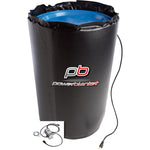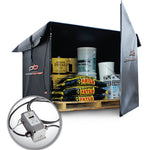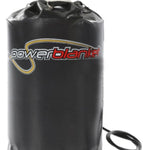You have no items in your shopping cart.
What is trace heating?
Article At-a-Glance
How Does Heat Trace Cable Work?
Heat trace cables work by using conductive wires and insulating materials to generate heat through electrical resistance, with self-regulating elements adjusting the heat output to maintain a consistent temperature, effectively preventing pipes from freezing or maintaining process temperatures.
Key Takeaways
- Understand the Components: Heat trace cables consist of conductive wires, insulating materials, and self-regulating elements like a semiconductive core, which work together to generate and control heat through electrical resistance.
- Mechanism of Heat Generation: These cables produce heat by converting electrical energy into thermal energy, using Ohm's law to create a heated zone along the cable's length, effectively replacing heat losses.
- Self-Regulation Explained: The self-regulating feature of heat trace cables allows them to adjust their heat output by increasing resistance as the surrounding temperature rises, ensuring consistent temperature maintenance.
- Applications and Benefits: Primarily used to prevent pipes from freezing, heat trace cables are essential in industries like oil and gas, manufacturing, and agriculture, offering energy-efficient and reliable temperature control solutions.
- Safety and Efficiency: Designed for safe use in various environments, including hazardous areas, heat trace systems can be enhanced with insulation and thermostats for maximum efficiency and precise temperature regulation.
Electrical trace heating or trace heating cables are an engineering process in which pipes are kept at high temperatures using specially designed cables and hoses. In winter months, temperatures can drop below freezing in winter. Often businesses use trace heating on their pipes and vessels to protect them from freezing at lower temperatures. If temperatures drop below freezing levels, pipes are susceptible to splintering due to ice expansion. The trace heating also keeps the ambient temperature in the water pipes and tanks manageable.
How does trace heating work?
A heat trace system or electric heat tracing can be achieved by connecting specially designed cables with resistance to the tube or vessels. Electrical cables are then utilized for maintaining temperature by replacing heat losses in electricity production. Using Ohms' law, the connection of voltages to wire or cable produces electricity that can subsequently convert to heat energy by the heat tracing system. Heat trace cables have two copper cables parallel to length, creating a heated zone where a resist filament is placed, resulting in a more efficient heating element. Upon supply of fixed voltage, constant power is produced, causing heat and cooling to this area. Many trace heating systems are managed by self-regulating heat, which allows you to maintain a constant wattage on your pipes to prevent freezing.
Tell me the best way to use heat-tracing cables
Typical heat trace cable systems are mainly used to prevent piping systems from freezing and subsequently busting during freezing temperatures. In cold temperatures, the problem is particularly prevalent on pipes with more exposure to cold temperatures. During freezes, pipeline ejection lines can break as heat is lost and the frozen liquid expands. Heat tracing provides much more than just thermal insulation and allows you to maintain a controlled ambient and pipe temperature. Successful trace heating systems maintain process temperature in the production plant for efficient operation.
What industries benefit most from using trace heating cables?
Some examples of industries that can benefit from heat tracing systems include the oil and gas industry, the transportation industry, the manufacturing industry, and the agricultural industry. Temperature maintenance in these industries drastically affects time and money, profit and loss, and the overall success of these companies.
The oil and gas industry is one of the most important industries that can benefit from heat tracing systems. Heat tracing cables can help to keep pipelines and other equipment functioning smoothly by preventing freezing or overheating. This is essential for the oil and gas industry, as any interruption in the flow of oil or gas can have a major impact on the economy.
The manufacturing industry is another important industry that can benefit from heat tracing systems. Trace heating cables can help to keep factories running smoothly by preventing the freezing or overheating of pipes and other equipment.
The agriculture industry also utilizes heat trace systems to keep equipment running smoothly. This is important for the agriculture industry, as any interruption in the flow of crops or livestock can become quite dangerous for the animals or the resulting crops.

Can Heat Tracing be used in hazardous areas?
Heat trace products are offered as a certification and approval option in Zone 1 and zone 2 areas. Self-regulated heat tapes are commonly employed in dangerous situations. More detailed information can be found here for heating in hazardous areas.
Does heat trace use a lot of electricity?
One of the most beneficial results of using heat trace cables for a temperature maintenance and freeze protection system is how much money it can save you. Instead of having to pay for the heating of entire warehouses or having to pay to fix broken or frozen pipes, you can spend your money by using a heating cable to apply direct heat to your pipes. It will use more electricity than just basic pipe insulation, but it will save you money by limiting the heat lost during low temperatures.
Does heat trace need to be insulated?
The heating cable will apply heat directly to your pipes or system and help you combat ambient temperature drops. It does this rather efficiently by itself, but if you add thermal insulation to your system as well, you will make your power output reach maximum efficiency. Insulation is not always required but is often strongly suggested as an addition to a successful heat trace system.

Does self-regulating heat trace need a thermostat?
Is it necessary to use a thermostat to have your trace heating cables work? Although trace heating is often self-regulating, it is not fully activated. We recommend using controllers and thermostats for this kind of heat system. Check out our article on the Guidelines for Using Heat Trace with a Thermostat to learn more.
Sizing a Heat Trace System
Typically heat trace connectors have to fit in a suitable size to suit the purpose of installation. Heat loss calculations have to be carried out, which include the insulation thickness and conductivity, as well as the ambient and pipe temperatures and the total volume of pipes. When heat loss is known, then heat trace cables are selected to provide the appropriate input voltage and jacket material.
How heat tracing can benefit you and your business
Heat trace is more affordable than both steam tracing and hot water tracing because it demands less upkeep and has a longer lifespan. When you can lay the heating tape across your system with no hassle and don't have to maintain it regularly, you save time not worrying about temperature changes and can instead focus on other aspects of production.
Heat tape is a more energy-efficient way to heat pipes and vessels than steam tracing or hot water tracing. This is because heat tape only heats the portion of the pipe or vessel that needs to be heated—not the entire system.
Not only does heating tape save energy, but it is also less difficult to install and manage. You can put it in tough-to-reach places or on oddly shaped vessels. And because the thermostat is adjustable, temperature regulation becomes much more accurate.
Heat tapes and heat cables are also more reliable than hot water tracing since they can resist freezing temperatures without sustaining any damage, unlike hot water piping. Given that extreme temperature changes are not uncommon, this option for a heat trace system provides you with much-needed security.
If you are ready to upgrade your pipe system to maintain consistent temperatures no matter what weather comes your way, check out our custom heating solutions or reach out to our Customer Service team today!













